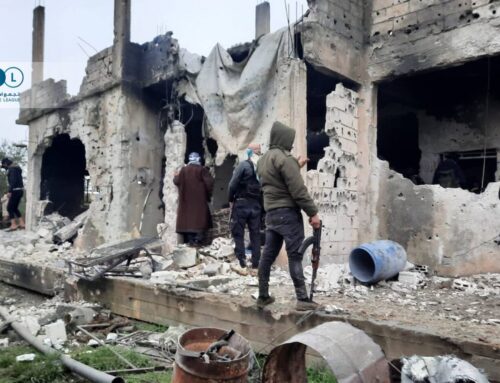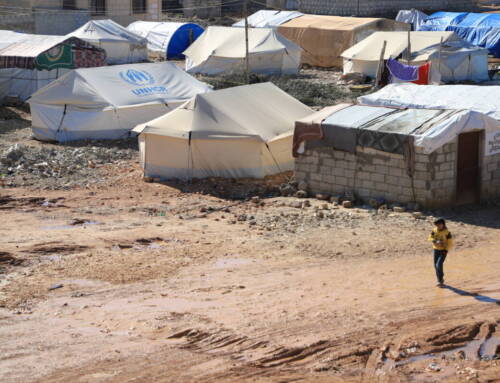Hama Media Office: IRGC presence ‘noticable’
February 16, 2015 Faced with a growing manpower crisis, the […]
16 February 2015
February 16, 2015
Faced with a growing manpower crisis, the Syrian regime has resorted to outsourcing some of its recruitment efforts in the city of Hama to the Iranian Revolutionary Guard Corps (IRGC), reported pro-opposition news outlet al-Souria late last month.
An IRGC military presence in Hama province was confirmed mid-last year when Abdullah Iskandri, an IRGC Ground Forces leader, was killed on the Morek front, reported pro-opposition Siraj Press.
The regime now relies more than ever on Iranian forces due to a lack of manpower in Hama, Syria’s most rebellious city and site of the massacre of tens of thousands of people in 1982 under President Hafez al-Assad.
“The Revolutionary Guard has a strong presence in the city of Hama; their presence has become noticeable recently,” Hassan al-Umri, alias of an employee with the pro-opposition Hama Media Office, tells Syria Direct’s Mohammed Al-Shamadin.
The Syrian army sometimes shares leadership with the Iranian forces considering their knowledge of the region’s geography, says al-Umri, but “it is the Iranian officer [who] remains the highest power and the decision-maker.”
Q: When did the Iranian Revolutionary Guard begin to have a military presence in Hama?
From the beginning of the revolution, Iranian elements fought alongside regime forces against the revolutionaries in the Hama countryside. The rebels found audio recordings, videos and pictures on the mobile phone of a regime soldier who was killed at the a-Zalaqiyat checkpoint after the rebels attacked the checkpoint and killed those inside.
These videos and pictures show Iranian and Afghani fighters side by side with regime forces at the checkpoint. Also, the spread of Iranians inside the city of Hama itself has been documented, the Hama Media Center broadcast several pictures of foreign fighters inside the city who are thought to be Iranian.
Q: To what extent do the Revolutionary Guard and Iranian leadership have a presence in Hama? Are they in leadership positions, or do they share that with the regime forces?
The Revolutionary Guard has a strong presence in the city of Hama; their presence has become noticeable recently.
Their main headquarters is the Qamhana area, whereas their largest military headquarters is Liwa 47, located on the Homs highway. The volunteers are trained there.
There are also a number of leaders and officers, perhaps the most prominent is the General Abdullah Iskandari, leader of the Revolutionary Guard who was killed in the middle of last year on the Morek front.
Most of the time the Revolutionary Guard Officers are in leadership positions and the regime forces fight under their orders. Sometimes the leadership is shared considering the regime forces’ knowledge of the region’s geography. But the Iranian officer remains the highest power and the decision-maker.
Q: As far as the salary that the IRGC pays out to recruits, is it fixed every month or paid in one installment?
The IRGC draws in young men by giving them monetary sums that reach up to SP50,000 ($265) every month. These salaries are disbursed every month, so that the soldiers don’t grumble and flee the ranks, especially considering that the Air Force Intelligence competes with the IRGC to draw in the largest number of volunteers.
The Air Force Intelligence gives recruits total control in the areas under their control, with monthly salaries that reach up to SP35,000 ($185) in cases of quiet and SP75,000 ($397) when clashes break out.
Q: What sorts of things do the new recruits do? Guard duty, or fighting on the fronts? Do volunteers with the IRGC stay in Hama or do they participate in fronts outside the city?
The IRGC volunteers’ role is [supposed to be] limited to securing points that the regime controls, as they’re being attacked, in Hama and its countryside.
Some of them wear military garb, others walk around in civilian clothing and their goal is to report on the neighborhoods’ news, and pressure the remaining young men to join the IRGC.
At first, the IRGC pledges to keep the volunteers in their neighborhoods and not throw them into the fronts. When the young men enroll, enticed by the incentives the IRGC offers, the IRGC delegate sends them to Liwa 47 and the Hama Military Airport under the pretext of training them and then returning them to their neighborhoods.
But after the training ends, they send them into battles with the Islamic State, and this is what happened to the young men of the Kafraa village in the northern Hama countryside, when they found themselves in front of the Islamic State in the Shaer gas fields in the Eastern Homs countryside.
Q: Who is responsible for the recruitment campaign? Iranians or Syrians?
The Iranian Revolutionary Guard oversees the campaign directly from their central headquarters in the Qamhana. There are a number of volunteer offices spread throughout the city; one next to the Immigration and Passports building, and another in the al-Arbayin neighborhood.
The Iranian Revolutionary Guard soldiers train the new recruits.
For more from Syria Direct, like us on Facebook or follow us on Twitter.






